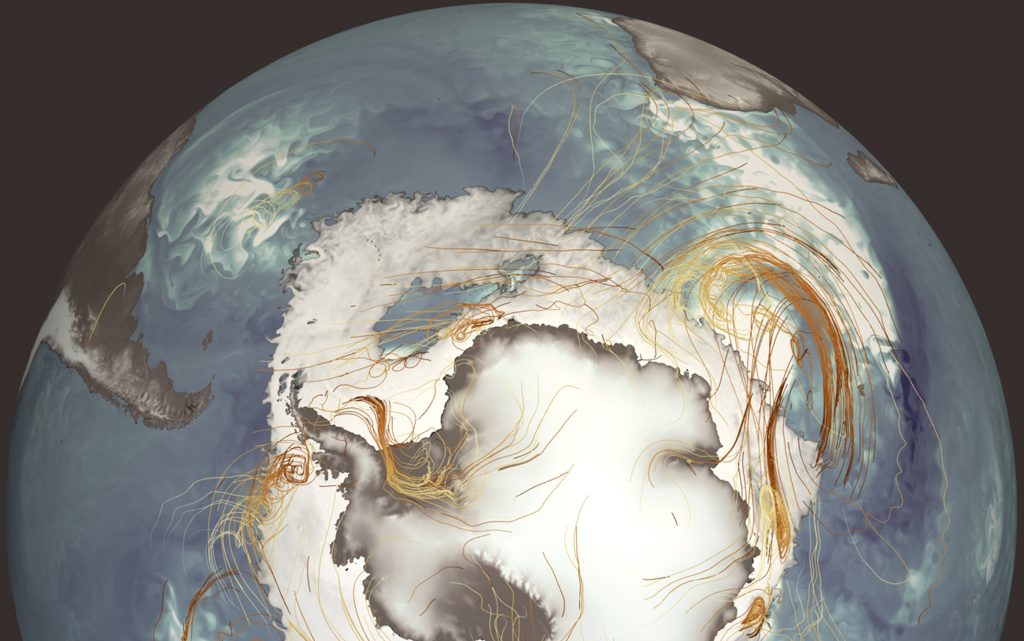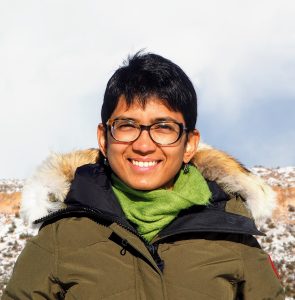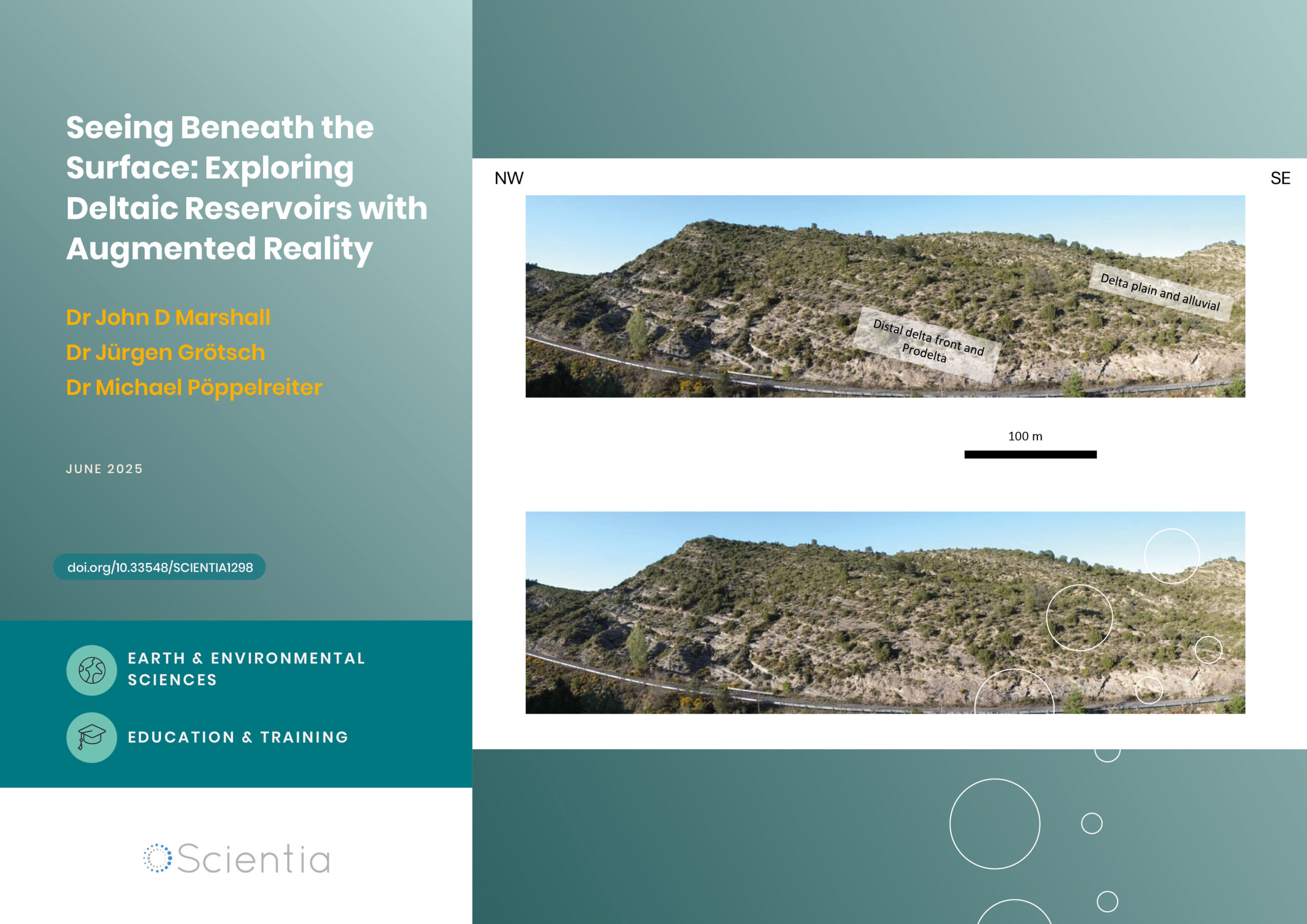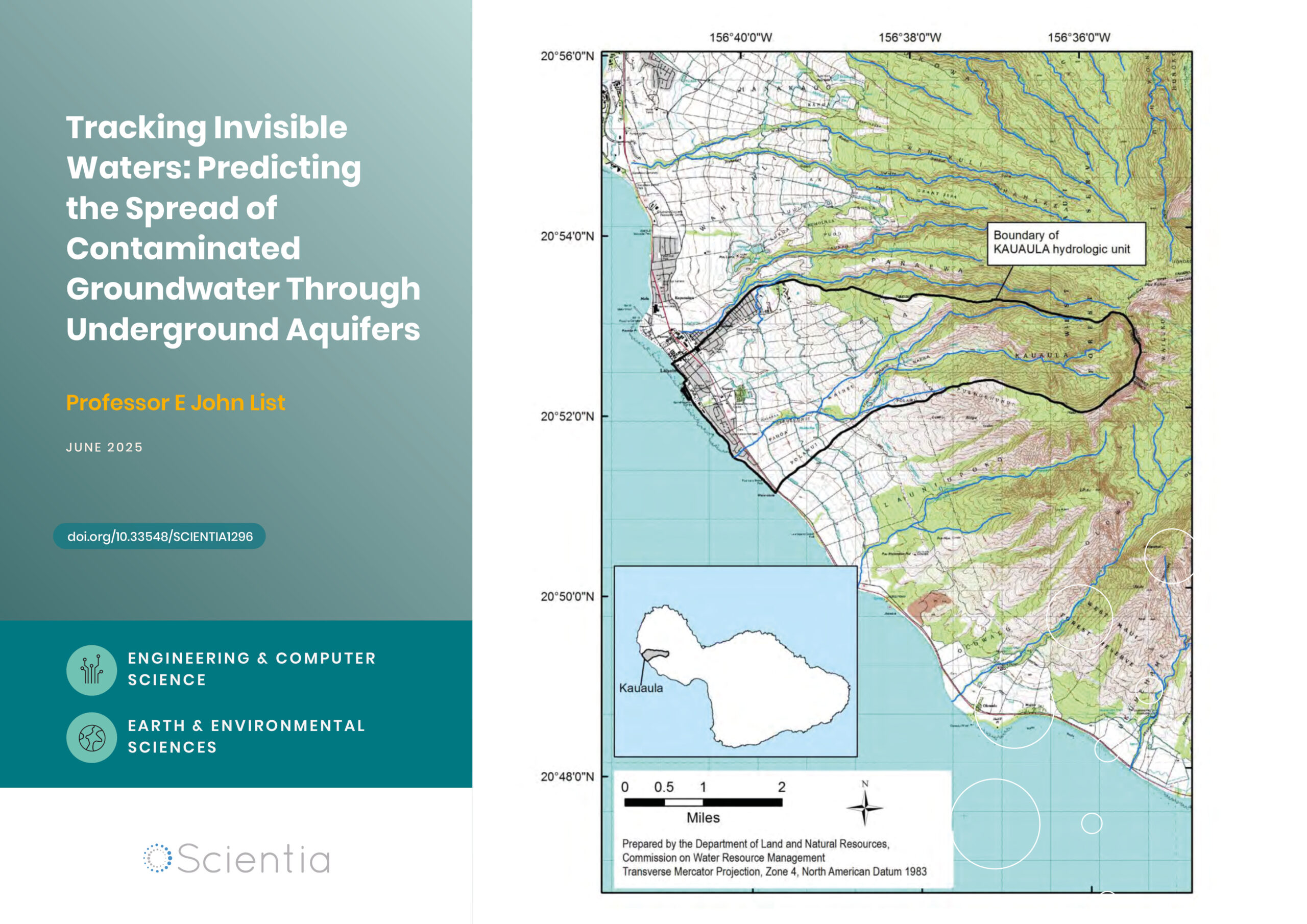Dr Prajvala Kurtakoti – Simulating Circulations in Earth’s Coldest Seas
Climate models typically use mathematical equations that govern geophysical fluid dynamics to describe the behaviours of the ocean, atmosphere, sea ice and land ice. Computer simulations that use climate models are an essential tool for capturing the complex, interacting motions found throughout Earth’s oceans and atmosphere. Using some of the most advanced simulation techniques available to date, Dr Prajvala Kurtakoti at Los Alamos National Laboratory aims to learn more about how these processes occur within the seas of Earth’s polar regions. Her team’s results are shedding new light on the intricate connections between the oceans and atmosphere, and how these systems are likely to change as the climate warms.
Simulating Change
Both on microscopic and continental scales, the motions of water and air throughout Earth’s oceans and atmosphere are vital to sustaining its ecosystems, and maintaining the stable climate patterns that enable life to thrive. However, as Earth’s climate heats up, the future stability of these patterns is looking increasingly uncertain. To understand how these mechanisms are changing in response to a warming climate, it is essential for researchers to capture them using computer simulations, which allow them to predict how future climate responses will vary in different scenarios – such as different amounts of carbon dioxide being emitted over the next few decades.
To achieve the levels of precision needed to achieve accurate predictions, these researchers must incorporate a detailed knowledge of how these processes occur, while also simulating systems with high enough resolutions to capture smaller-scale mechanisms – which often have a strong influence over larger-scale behaviours. Unfortunately, however, many of these capabilities are still lacking in current approaches.
In her research, Dr Prajvala Kurtakoti of Los Alamos National Laboratory uses cutting-edge simulation approaches to improve on these capabilities. So far, her team’s research has focused on two particularly interesting scenarios – including ocean circulation in Antarctica’s Weddell Sea, and the transfer of heat between the ocean and atmosphere in the Arctic Ocean.
Upwelling Ocean Currents
Although they are hidden from our view, the topographies on the seafloor are no less dramatic than they are on land. Featuring mountains, trenches and vast plains, the widely varying depth of the ocean floor is described through its ‘bathymetry’. Just as mountains and plains on land can have profound influences over atmospheric circulation and weather patterns, bathymetric effects can heavily influence the behaviour of ocean currents, including systems of circulating currents, named ‘gyres’.
One region where this effect is particularly important to consider is the Southern Ocean, where currents in the deep ocean can interact with raised features such as seamounts, forcing them up to interact with the surface. This effect is particularly vital to Antarctica’s ecosystem, as it draws up essential nutrients from the ocean floor. Seamounts nurture and sustain large ecosystems in regions where it would otherwise be impossible. This phenomenon is also observed in large areas of open water named ‘polynyas’, which remain surrounded by sea-ice.
Particularly striking polynyas were once found in the Weddell Sea – the southernmost reach of Earth’s oceans. This sea features its own gyre, the Weddell gyre, which transports warm, salty water at depths ranging from 200 to 1,500 metres – supplied by an offshoot of the ocean current that circumnavigates the entire Antarctic continent, the Antarctic Circumpolar Current. At one time, this region also supported a vast polynya, which occurred in the depths of Antarctica’s winter. Mysteriously, however, this feature hasn’t been seen for decades.
A Lost Polynya
The Weddell gyre’s path is intercepted by an underwater seamount named the Maud Rise, which elevates the ocean floor by over 3,000 metres. As it interacts with this seamount, the current is driven upwards, forcing it to mix with water on the surface. Over three consecutive winters from 1974 to 1976, in and around this region, some of the earliest satellite observations of Antarctica revealed a vast polynya, around the size of the UK – transferring large amounts of heat from the ocean to the atmosphere.
Intriguingly, this Weddell Sea Polynya has never been observed since. In its place however, a smaller-scale feature named the Maud Rise Polynya, measuring roughly 200 kilometres across, still occurs sporadically – and was observed most recently in the winters of 2016 and 2017. In previous studies, researchers have used climate simulations to conclude that the sudden disappearance of the Weddell Sea Polynya can be attributed to alterations in the both the Weddell Sea surface temperature and salinity, and its wind patterns, ultimately brought about by manmade climate change.
Yet with their limited resolutions, these previous models couldn’t capture the smaller-scale mechanisms responsible for the Weddell Sea Polynya in sufficient detail to explain how its emergence was connected to the Maud Rise Polynya. In a pair of recent studies (Kurtakoti et al. 2018, 2021), Dr Kurtakoti and her colleagues explored this link using an advanced simulation tool named the Earth System Model.

Cross-section through a polynya over Maud Rise seamount in a high-resolution E3SM simulation (Caldwell et al. 2019). The cross-section shows winter salinity with depth. The colour lines are surface winds streamlines and their colour indicates their age going from yellow (1-day) to red (10-day). CREDIT: Abram & Samsel, TACC, UT Austin.
Uncovering Triggers
By accounting for the motions of the ocean and atmosphere down to resolutions as small as 10 kilometres, Dr Kurtakoti’s team could reliably recreate the ice-free conditions of the Weddell Sea Polynya, and assess the responsible triggering mechanisms. From their results, they concluded that the formation of the polynya tends to coincide when the position of the Southern Hemisphere westerlies, a ring of strong winds surrounding the entire Antarctic continent, take a more southerly route than usual.
Although this behaviour is associated with drier conditions at the surface of the ocean in the Weddell Sea, Dr Kurtakoti and colleagues showed that the wind patterns enable a build-up of heat in the deep ocean, which is essential for sustaining polynyas.
Ultimately, they demonstrated that larger Weddell Sea Polynyas can only be triggered by particularly pronounced Maud Rise Polynyas – which generate high levels of salinity and temperature at the surface through mixing, allowing the water to remain ice-free well below the freezing point of the surrounding surface seawater. Afterwards, this water is driven westwards by the Weddell gyre – significantly expanding the area of open water. These results highlight how climate change has greatly reduced the likelihood of these anomalies from occurring simultaneously, and offer new insights into how the unique characteristics of Antarctic sea-ice can be expected to change in the near future.
Virtual Recreations
In many climate models, the processes occurring in Earth’s oceans, atmosphere, land areas, rivers, and sea ice are only accounted for one at a time. In reality, however, these variables are each deeply interconnected. Through her previous discoveries, Dr Kurtakoti has played a key role in a recent study, which used an advanced climate model to produce visually striking animated animations of polynya formation in the seas surrounding Antarctica (Caldwell et al. 2019).
In their study, a collaboration of researchers including climate modellers, computer scientists and an artist, used a powerful simulation tool named the Energy Exascale Earth System Model (E3SM). This model constructs a detailed overlay of the many interacting variables that affect Earth’s oceans and atmosphere. In the end, the team’s simulation was one of the highest-resolution climate models ever run – resolving features as small as six kilometres for the sea ice and oceans in polar regions. E3SM also displayed a remarkably high time resolution – producing six global-scale snapshots every hour.
With these measures in place, Dr Kurtakoti and her colleagues observed a Weddell Sea Polynya forming after 64 virtual years. The result provided further key insights into the polynya’s influence on its surrounding environment – including the upwelling plumes of salty water from the ocean floor beneath it, driven by cold meltwater on the surface. As a result, the simulation provides a powerful tool for groups ranging from climate experts, to members of the public, as they aim to visualise the deep complexity of the processes that play out within polar sea ice.
Bjerknes Compensation
In her latest research, Dr Kurtakoti has begun to investigate another important effect, which explains how large anomalies in the heat transported between the oceans and atmosphere should roughly balance each other out. The atmosphere and ocean transport about five quadrillion watts of energy poleward annually, at 43 degrees north and 40 degrees south. The partitioning of this energy into atmospheric and oceanic heat transport is essential for constraining the response of the climate system. Bjerknes Compensation (BJC) occurs when a change in ocean heat transport is compensated for by an opposite change in atmospheric heat transport. This behaviour can only occur when the flow rates of heat contained both in the ocean, and at the top of the atmosphere, each remain roughly equal and opposite.
This behaviour has been shown to hold true in earlier climate models over decades-long timescales in the high-latitude areas of the northern hemisphere. So far, however, the validity of BJC hasn’t yet been confirmed in more complex models – or indeed in the real world. A key factor to consider is the ratio between the heat anomalies transported by the atmosphere to that by the ocean. If this value becomes more unbalanced, it would indicate that BJC has broken down – so that any changes to the heat transported by the ocean will not necessarily be accompanied by a corresponding change in the atmosphere. The physical interpretation of this would be an unstable climate in the high-latitude areas of the northern hemisphere.

Sea ice thickness (white), ocean latent heat flux (white/blue), and streamlines of winds (yellow/red), around Antarctica during a Weddell Sea Polynya in a high-resolution E3SM simulation (Caldwell et al. 2019). CREDIT: Abram & Samsel, TACC, UT Austin.
Simulating Heat Transfers
To identify whether BJC offers a valid description of how heat is exchanged between Earth’s oceans and atmosphere, Dr Kurtakoti’s team is studying the CMIP6 experiments – a series of advanced climate simulations carried out by the World Climate Research Programme. This time, the researchers are focusing on several different regions of the Arctic, including the Labrador Sea between Canada and Greenland, and the Norwegian and Barents Seas bordering Scandinavia and Russia.
Using around 30 simulations, the team has now assessed the degree to which BJC held over decades-long timescales. The simulations incorporated a variety of carbon emissions scenarios; in some, levels of atmospheric carbon were kept the same as those present before the onset of global-scale industry.
Here, BJC emerged in multiple simulations – so that any increases in heat transfer from the atmosphere to the ocean were balanced out by a decrease in poleward atmospheric heat transport. Intriguingly, these simulations still indicted a wide range of BJC ratios – with atmospheric and oceanic heat transfers both perfectly compensating each other in some cases, and heavily over- or under-compensating in others.
In other simulations, the case in the 21st century was presented more closely. Here, levels of virtual atmospheric carbon were abruptly quadrupled, and then held constant. In this case, Dr Kurtakoti’s team shows that BJC is significantly reduced in the Arctic regions they studied. This occurred due to the fact that the ocean and the atmosphere in the polar regions are no longer strongly interconnected. This effect is amplified in Earth’s coldest regions.
Understanding Imbalanced Ratios
Having investigated these behaviours, the next major challenge for Dr Kurtakoti and her colleagues will be to identify the mechanisms that determine the balance between both types of heat transfer. Currently, they are investigating the role of clouds, whose bright surfaces tend to reflect radiation from the Sun, keeping ocean and atmospheric temperatures cooler. In addition, they will consider the effect of reflective sea-ice – which also has a significant cooling effect, but whose coverage is decreasing as the seas of the Arctic rapidly heat up.
For now, the mechanisms that drive the wide variations in BJC ratios remain uncertain – but already, Dr Kurtakoti’s team has made important strides towards understanding their real-world significance. In the future, their results could allow researchers to make better predictions of how circulations and heat transfers in the oceans and atmosphere – especially in polar regions, where climate change is happening more rapidly than anywhere else on Earth.
SHARE
DOWNLOAD E-BOOK
REFERENCE
https://doi.org/10.33548/SCIENTIA808
MEET THE RESEARCHER

Dr Prajvala Kurtakoti
Centre for Nonlinear Studies
Los Alamos National Laboratory
Los Alamos, NM
USA
Dr Prajvala Kurtakoti achieved a Bachelor’s degree in Computer Science and Engineering in 2008. After graduation, she worked on an internship at the Centre for Atmospheric and Oceanic Sciences, the Indian Institute of Science, studying the Asian monsoon. She then pursued a Master’s in Physical Oceanography at Memorial University of Newfoundland, Canada, and a PhD in Oceanography at Texas A&M University, where she graduated in 2019. Since then, Dr Kurtakoti has been working as a postdoctoral research associate at the Center for Nonlinear Studies, Los Alamos National Laboratory. As a polar oceanographer, she has a particular interest in using computer simulations to study the impacts of climate change on ocean circulation patterns. She leads two research projects, one focused on the Arctic Ocean and the other on the Southern Ocean. Dr Kurtakoti studies various complex interactions among small-scale and large-scale physical processes in the Weddell Sea while evaluating DOE’s Earth System Model (E3SM). She also studies how variations in the atmospheric and oceanic heat transport behave on decadal and longer timescales across the Coupled Model Intercomparison Project Phase 6 (CMIP6) experiments. She also enjoys investigating the fields of geophysical and stratified fluid dynamics, and conducting lab experiments on internal gravity waves. During her PhD, Dr Kurtakoti won an award for her exceptional work in teaching undergraduate students.
CONTACT
E: prajvala@lanl.gov
W: https://www.prajvalakurtakoti.com/
KEY COLLABORATORS
Dr Wilbert Weijer, Los Alamos National Laboratory
Dr Milena Veneziani, Los Alamos National Laboratory
Dr Xylar Asay-Davis, Los Alamos National Laboratory
Dr Mathew Maltrud, Los Alamos National Laboratory
Dr Achim Stössel, Texas A&M University
Dr Philip Rasch, Pacific Northwest National Laboratory
Dr Tarun Verma, Princeton University
Dr Greg Abram, University of Texas at Austin
Dr Francesca Samsel, University of Texas at Austin
FUNDING
The US Department of Energy, through the LANL/LDRD Program and the Center for Non-Linear Studies
The High-Latitude Application and Testing of Earth System Models (HiLAT-RASM) project
FURTHER READING
P Kurtakoti, M Veneziani, A Stössel, W Weijer, M Maltrud, On the Generation of Weddell Sea Polynyas in a High-Resolution Earth System Model, Journal of Climate, 2021, 34, 2491.
PM Caldwell, and co-authors, The DOE E3SM Coupled Model Version 1: Description and Results at High Resolution, Journal of Advances in Modeling Earth Systems, 2019, 11, 4095–4146.
P Kurtakoti, M Veneziani, A Stössel, W Weijer, Preconditioning and formation of Maud Rise polynyas in a high-resolution Earth system model, Journal of Climate, 2018, 31, 9659.
REPUBLISH OUR ARTICLES
We encourage all formats of sharing and republishing of our articles. Whether you want to host on your website, publication or blog, we welcome this. Find out more
Creative Commons Licence (CC BY 4.0)
This work is licensed under a Creative Commons Attribution 4.0 International License. 
What does this mean?
Share: You can copy and redistribute the material in any medium or format
Adapt: You can change, and build upon the material for any purpose, even commercially.
Credit: You must give appropriate credit, provide a link to the license, and indicate if changes were made.
SUBSCRIBE NOW
Follow Us
MORE ARTICLES YOU MAY LIKE
Dr Shigetaka Hayano | The Rubber Revolution: Cracking the Code for Tire Recycling!
Traditionally, rubber waste was nearly impossible to recycle due to crosslinked sulphur bonds. But a team of researchers led by Dr Shigetaka Hayano from Zeon Corporation, in Japan, have achieved a groundbreaking feat in rubber recycling. Using mild conditions for the reaction, scientists have overcome the unfavourable cross-linked structure and have achieved recovery of rubber’s original monomers. This process restores cyclopentene monomers with 90% efficiency, allowing old tires and industrial rubber waste to be chemically recycled into high quality materials. If scaled up, this innovation could revolutionise waste management, reduce environmental pollution, and enable a circular economy for rubber production.
Seeing Beneath the Surface: Exploring Deltaic Reservoirs with Augmented Reality
In the Aínsa Basin of the Spanish Pyrenees, the Mondot-1 well was drilled, cored, and fully logged to capture a detailed record of a long-buried ancient river delta system. Dr. John D. Marshall, Dr. Jürgen Grötsch, and Dr. Michael C. Pöppelreiter with co-workers at Shell International used this core to trace how sediments once flowed across the landscape, and were deposited under shifting tectonic conditions. The team employed augmented reality and interactive virtual displays; these innovative tools offer new ways to explore subsurface depositional systems, and are particularly useful in locations where physical access to the core is difficult, or no longer possible.
Professor E John List | Tracking Invisible Waters: Predicting the Spread of Contaminated Groundwater Through Underground Aquifers
When we think about water pollution, we often picture oil spills on the ocean surface or chemicals flowing down rivers. But some of the most significant environmental challenges occur completely out of sight, deep underground, where contaminated water moves through layers of rock and soil. Understanding how these invisible pollutants travel has profound implications for protecting our drinking water supplies and coastal ecosystems. Groundwater engineer Dr E. John List has developed an approach that challenges fundamental assumptions about how contamination spreads underground.
Dr Richard Marchant | Restoring the Flow: Stream Life Slowly Returns After Rabbit Eradication on Macquarie Island
The remote streams of subantarctic Macquarie Island are home to low diversity freshwater invertebrate communities with an unusual taxonomic composition. However, over a century of grazing by introduced rabbits dramatically degraded surrounding vegetation, increasing erosion and disturbing stream ecosystems. Following rabbit eradication in 2016, Dr Richard Marchant of Museums Victoria and colleagues from the University of Canberra and the Australian Antarctic Division investigated whether the island’s streams were recovering ecologically. Their study reveals a slow but measurable resurgence of invertebrate taxa, particularly in areas with moderate prior damage and vegetation regrowth, though full recovery remains uncertain.





